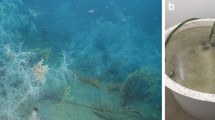Abstract
Sweeper tentacles of Galaxea fascicularis have a different nematocyst composition than do ordinary tentacles. The sweeper tentacles contain many large microbasic b-mastigophores (MbM) instead of the microbasic p-mastigophores (MpM) which are abundant in the acrospheres of ordinary tentacles. There is, however, an intermediate type of tentacle which has both large MbM and MpM. These tentacles may represent those undergoing transformation from ordinary into sweeper tentacles or vice versa. Two polyps isolated from the same colony (syngeneic pairs), or from colonies belonging to different colour morphs (presumed allogeneic pairs), were set about 5 mm apart with tentacles touching, and then maintained for about two months in this position. Tissue fusion was observed only in syngeneic pairs. In some allogeneic combinations, one polyp of the pair was damaged or killed by the other. The dominant polyp developed many sweeper tentacles. In other allogeneic combinations, both polyps survived and no, or only a few, sweeper tentacles were formed. Tissue fusion also failed to occur in the allogeneic combinations.
Similar content being viewed by others
References
Bak RPM, Termaat RM, Dekker R (1982) Complexity of coral interactions: influence of time, location of interaction and epifauna. Mar Biol 69:215–222
Bigger CH (1980) Interspecific and intraspecific acrorhagial aggressive behavior among sea anemones: a recognition of self and not-self. Biol Bull 159:117–134
Bothwell AM (1982) Fragmentation, a means of asexual reproduction and dispersal in the coral genus Acropora (Scleractinia: Astrocoeniida: Acroporidae) — a preliminary report. Proc 4th Int Coral Reef Symp 2:137–144
Chornesky EA (1983) Induced development of sweeper tentacles on the reef corals Agaricia agaricites: a response to direct competition. Biol Bull 165:569–581
Chornesky EA, Williams SL (1983) Distribution of sweeper tentacles on Montastrea cavernosa. In: Reaka ML (ed) The ecology of deep and shallow coral reefs. Symposium Series on Undersea Research, National Office of Undersea Research, NOAA, Rockville, Maryland, pp 61–67
Cutress CE (1955) An interpretation of the structure and distribution of cnidae in Anthozoa. Syst Zool 4:120–137
Ertman SC, Davenport D (1981) Tentacular nematocyst discharge and “self-recognition” in Anthopleura elegantissima Brandt. Biol Bull 161:366–370
Francis L (1976) Social organization within clones of the sea anemone Anthopleura elegantissima. Biol Bull 150:361–376
Hartog JC den (1977) The marginal tentacles of Rhodactis sanctithomae (Corallimorpharia) and the sweeper tentacles of Montastrea cavernosa (Scleractinia); their cnidom and possible function. Proc 3rd Int Coral Reef Symp 1:463–469
Hidaka M, Yamazato K (1982) Effect of light on budding of isolated polyps of the scleractinian coral Galaxea fascicularis. Galaxea 1:65–75
Hildemann WH, Linthicum DS, Vann DC (1975) Transplantation and immunoincompatibility reactions among reef-building corals. Immunogenetics 2:269–284
Hildemann WH, Raison RL, Hull CJ, Akaka L, Okamoto J, Cheung G (1977) Tissue transplantation immunity in corals. Proc 3rd Int Coral Reef Symp 1:537–543
Jokiel PL, Hildemann WH, Bigger CH (1983) Clonal population structure of two sympatric species of the reef coral Montipora. Bull Mar Sci 33:181–187
Kawaguti S (1941) Abnormal tentacles of Galaxea. Kagaku Nanyo 3:40–41 (in Japanese)
Lewis JB, Price WS (1975) Feeding mechanisms and feeding strategies of Atlantic reef corals. J Zool 176:527–545
Lubbock R (1980) Clone-specific cellular recognition in a sea anemone. Proc Natl Acad Sci 77:6667–6669
Mariscal RN (1974) Nematocysts. In: Muscatine L, Lenhoff HM (eds) Coelenterate biology: reviews and new perspectives. Academic Press, New York London, pp 129–178
Neigel JE, Avise JC (1983) Clonal diversity and population structure in a reef building coral, Acropora cervicornis: self-recognition analysis and demographic interpretation. Evolution 37:437–453
Potts DC (1976) Growth interactions among morphological variants of the coral Acropora palifera. In: Mackie GO (ed) Coelenterate ecology and behaviour. Plenum Press, New York, pp 79–88
Potts DC (1978) Differentiation in coral populations. Atoll Res Bull 220:55–74
Purcell JE (1977) Aggressive function and induced development of catch tentacles in the sea anemone Metridium senile (Coelenterata, Actiniaria). Biol Bull 153:355–368
Richardson CA, Dustan P, Lang JC (1979) Maintenance of living space by sweeper tentacles of Montastrea cavernosa, a Caribbean reef coral. Mar Biol 55:181–186
Rinkevich B, Loya Y (1983) Intraspecific competitive networks in the Red Sea coral Stylophora pistillata. Coral Reefs 1:161–172
Schmidt H (1974) On evolution in the Anthozoa. Proc 2nd Int Coral Reef Symp 1:533–560
Sheppard CRC (1980) Coral cover, zonation and diversity on reef slopes of Chagos atolls, and population structures of the major species. Mar Ecol Prog Ser 2:193–205
Watson GM, Mariscal RN (1983) The development of a sea anemone tentacle specialized for aggression: morphogenesis and regression of the catch tentacle of Haliplanella luciae (Cnidaria, Anthozoa). Biol Bull 164:506–517
Wellington GM (1980) Reversal of digestive interactions between Pacific reef corals: mediation by sweeper tentacles. Oecologia 47:340–343
Author information
Authors and Affiliations
Rights and permissions
About this article
Cite this article
Hidaka, M., Yamazato, K. Intraspecific interactions in a scleractinian coral, Galaxea fascicularis: Induced formation of sweeper tentacles. Coral Reefs 3, 77–85 (1984). https://doi.org/10.1007/BF00263757
Accepted:
Issue Date:
DOI: https://doi.org/10.1007/BF00263757




